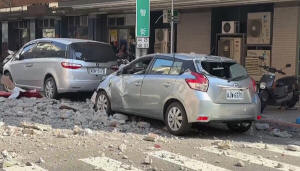|
The biggest of the quakes hit at 10:11 a.m. (0211 GMT) in Chiayi
county’s Dapu township at a depth of 10 kilometers (6 miles),
according to the Central Weather Agency and the U.S. Geological
Survey. The epicenter was about 250 kilometers (155 miles) south
of the capital, Taipei, where buildings swayed slightly.
That was followed shortly afterward by at least a dozen smaller
quakes in Dapu. All were aftershocks from a magnitude 6.4
earthquake that struck Dapu on Jan. 21 and sent 15 people to the
hospital with minor injuries, as well as damaging buildings and
a highway bridge.
No injuries were reported from Thursday's quake, although crews
were dispatched to clear away tiles and signage that had been
shaken off buildings. Train service was also suspended for 70
minutes on the island's north-south high-speed rail while safety
checks were conducted, and speeds on slower trains were also
reduced.
Thursday was a a major travel during the weeklong Lunar New Year
festival.
Last April, a magnitude 7.4 quake hit the island’s mountainous
eastern coastal county of Hualien, killing at least 13 people,
injuring more than 1,000 others, collapsing a hotel and forcing
the closure of Toroko National Park. That was the strongest
earthquake in 25 years and was followed by hundreds of
aftershocks.
Taiwan is going through a period of increased seismic activity
that could lead to further aftershocks or new quakes, although
they are unlikely to be majorly destructive, according to the
CWA and earthquake experts.
“This was a third wave of quakes, and if there is a fourth wave
it will likely be smaller,” said Kuo Kai-wen, former head of the
CWA's Seismological Center.
Taiwan lies along the Pacific “Ring of Fire,” the line of
seismic faults encircling the Pacific Ocean from Chile to New
Zealand where most of the world’s earthquakes occur.
The 1999 magnitude 7.7 quake killed 2,415 people, damaged
buildings around the island of 23 million people and led to
tightened building codes, better response times and coordination
and widespread public education campaigns on earthquake safety.
Schools and workplaces hold earthquake drills, while cellphones
buzz whenever a strong earthquake is detected.
All contents © copyright 2025 Associated Press. All rights
reserved |
|




